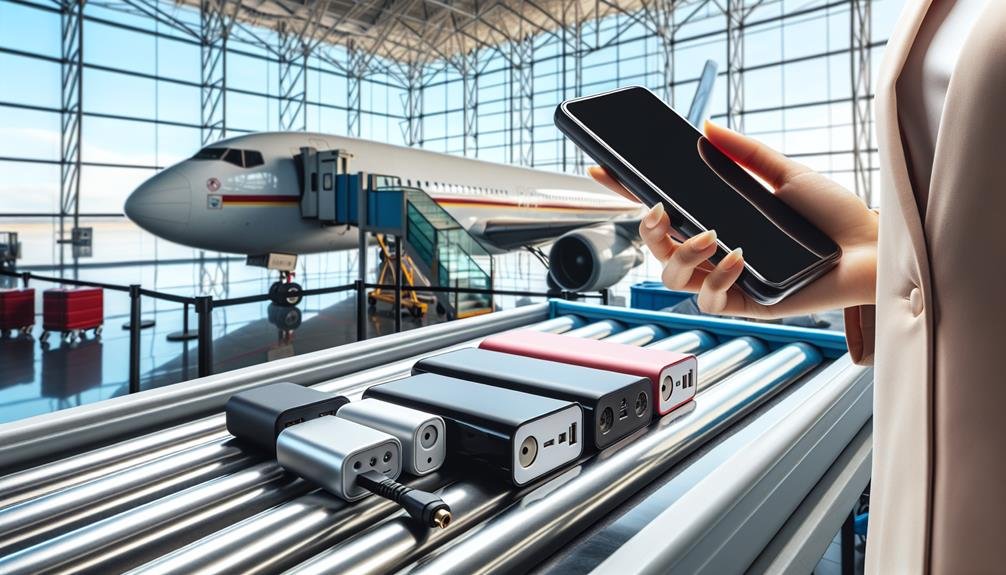You can bring power banks on planes, but they must be in your carry-on luggage. They should have a clearly marked capacity and typically can't exceed 100 watt-hours. If your power bank is between 100 and 160 watt-hours, you'll need airline approval. Never pack them in checked baggage due to the risk of malfunctions. Confirm your power bank has safeguards against overcharging or short-circuiting. Verify specific airline regulations, as some have additional rules. Following these guidelines guarantees a smooth security check and safe travel. Learn more tips to make your journey hassle-free.
Airline Regulations
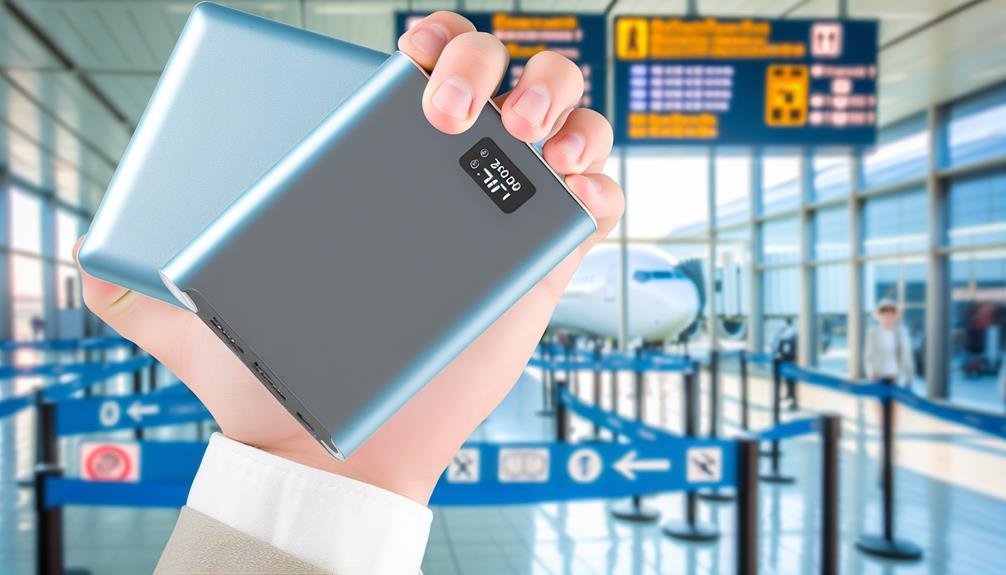
When it comes to carrying power banks on planes, you'll need to follow specific airline regulations to guarantee compliance and safety. Portable chargers are considered travel essentials, but their transport is subject to stringent rules. Airlines and regulatory bodies like the FAA and IATA have set guidelines to minimize risk.
First, always carry your power bank in your carry-on baggage. Stowing them in checked luggage is generally prohibited due to the fire risk associated with lithium-ion batteries. Adhering to this rule is an important safety precaution.
Next, airlines typically require that the power bank's capacity be clearly marked. Unmarked chargers may be confiscated at security checkpoints. Make sure that your portable charger displays its capacity information visibly to avoid complications.
Furthermore, be aware of any specific travel regulations your airline might have. While most airlines follow international safety standards, some might have additional restrictions or requirements. Always check with your airline before traveling to make certain all your devices meet their criteria.
Lastly, avoid using the power bank during takeoff and landing. This practice minimizes potential interference with the aircraft's systems, aligning with general safety precautions. By following these guidelines, you can guarantee a safe and hassle-free journey with your essential portable chargers.
Capacity Limits
Airlines impose strict capacity limits for power banks, typically capping them at 100 watt-hours (Wh) per device to safeguard passenger safety. This limit adheres to international safety guidelines, guaranteeing that high-capacity batteries don't pose a risk during flights. If your power bank exceeds this capacity, it might be subject to additional scrutiny or outright banned from your carry-on.
To help you stay within the airlines' regulations, here are key points to keep in mind:
- Charging Restrictions: Check that your power bank's capacity is clearly labeled. Devices over 100 Wh but under 160 Wh might be allowed with prior airline approval. Always consult with your airline before traveling.
- Usage Limitations: Power banks must be carried in your hand luggage, not in checked baggage. This rule helps mitigate risks associated with battery fires, as cabin crew can quickly address any issues that arise.
- Storage Requirements: Store power banks properly in your carry-on. Avoid keeping them near metal objects or liquids, which could cause short circuits or other malfunctions.
Following these guidelines will help you navigate the complexities of flying with power banks, ensuring a safe and hassle-free journey.
Lithium-Ion Restrictions
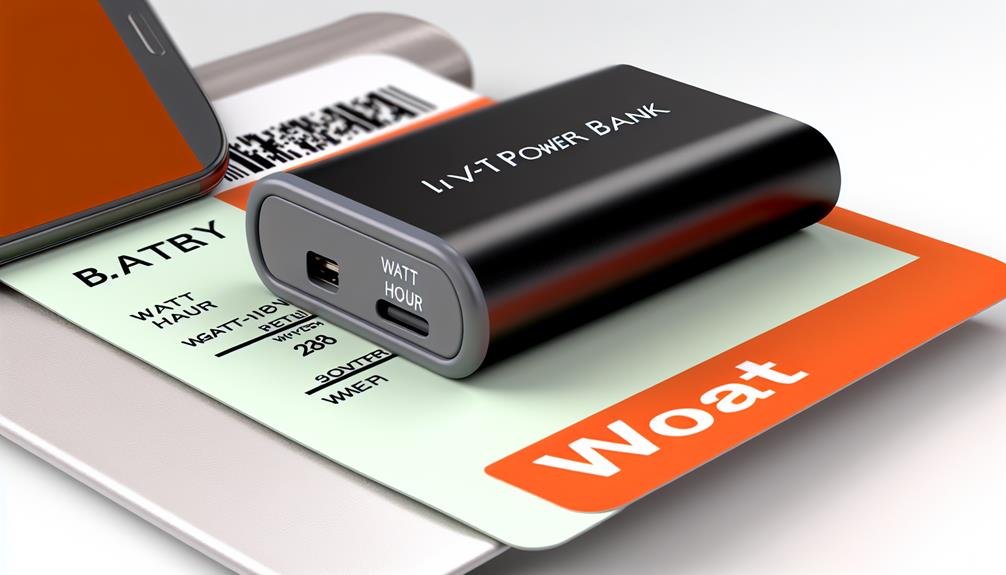
You're allowed to carry lithium-ion power banks on planes, but they must adhere to specific battery capacity limits. Additionally, spare batteries must be packed in your carry-on bag and cannot exceed 100 watt-hours without airline approval. Always check individual airline policies, as rules might vary.
Battery Capacity Limits
Most airlines limit lithium-ion power banks to a maximum capacity of 100 watt-hours (Wh) per battery. This limitation is in place to safeguard passenger safety and abide by international regulations. When you're packing your travel essentials, it's essential to check the capacity of your portable chargers to avoid any issues at airport security.
Here are some key points to keep in mind:
- Charging Restrictions: Airlines enforce strict charging limitations. Power banks over 100 Wh typically require airline approval, and those over 160 Wh are generally prohibited.
- Safety Guidelines: Always adhere to safety guidelines by packing power banks in your carry-on luggage. This reduces risks associated with battery malfunctions in the cargo hold.
- Label Verification: Confirm the battery capacity label on your power bank. Most manufacturers list the Wh rating, making it simpler to verify compliance.
Spare Battery Rules
While it's important to keep an eye on power bank capacities, you should also be aware of the rules surrounding spare lithium-ion batteries when flying. Airlines and aviation authorities impose strict safety regulations to prevent potential hazards associated with these batteries.
Firstly, you need to know that spare lithium-ion batteries must be carried in your carry-on baggage. Storing them in checked luggage is prohibited due to fire risks. Guarantee each battery is individually protected to prevent short circuits, using original packaging or insulating tape on exposed terminals.
Regarding battery types and capacities, spare lithium-ion batteries under 100 watt-hours (Wh) are generally permitted without restriction. However, for batteries between 100Wh and 160Wh, you can typically carry up to two, but you'll need airline approval. Batteries over 160Wh are usually not allowed, except for specific medical devices, and even then, you'll need explicit permission.
Charging restrictions are also essential. You can't charge spare batteries or power banks during the flight. This precaution minimizes overheating risks. Following these storage guidelines and safety regulations will help guarantee a safe and hassle-free journey. Always check with your airline for their specific rules and updates.
Carry-On Vs Checked
When flying, you're required to carry power banks in your carry-on luggage, not checked baggage. Confirm your power bank adheres to airline-specific regulations, particularly regarding lithium-ion battery capacity limits. Always check for any additional restrictions imposed by the airline to avoid complications.
Power Bank Size Limits
To secure safety, airlines enforce strict regulations on the size of power banks allowed in carry-on and checked baggage. Understanding these size restrictions assures you can meet your travel essentials and charging needs without any hassle. Generally, power banks must be kept in your carry-on baggage due to their lithium-ion batteries, which are sensitive to pressure and temperature changes in the cargo hold.
Here's a quick breakdown of the size restrictions based on travel regulations:
- Up to 100Wh: Power banks with a capacity of up to 100 watt-hours (Wh) are usually allowed in carry-on baggage without prior approval. These are typically sufficient for most travel essentials and charging needs.
- Between 100Wh and 160Wh: Power banks in this range may require airline approval before you can bring them on board. You can usually carry up to two of these in your carry-on.
- Above 160Wh: Power banks exceeding 160Wh are generally prohibited in both carry-on and checked baggage. Special arrangements must be made if you need to transport such high-capacity devices.
Lithium-Ion Battery Restrictions
Airlines have strict restrictions on lithium-ion batteries, mandating that they must be carried in your carry-on baggage rather than checked luggage. This requirement is primarily driven by battery safety concerns. Lithium-ion batteries, commonly used in power banks, pose a potential fire risk if damaged or short-circuited. When stored in the cabin, crew members can quickly address any issues, whereas fires in the cargo hold are harder to detect and manage.
For your travel convenience, make sure that your power bank complies with airline restrictions. Most airlines allow lithium-ion batteries with capacities up to 100 watt-hours (Wh) in carry-on baggage without prior approval. For batteries between 100Wh and 160Wh, you typically need the airline's approval. Batteries exceeding 160Wh are generally prohibited. This regulation reflects the advancements in battery technology, balancing convenience and safety.
Airline-Specific Regulations
Understanding the general restrictions on lithium-ion batteries, let's now examine the specific regulations airlines impose on carrying power banks in your carry-on versus checked baggage. Knowing these regulations guarantees you adhere to charging restrictions and follow necessary safety precautions.
- Carry-On Baggage: Most airlines allow you to carry portable chargers with a capacity of up to 100Wh in your carry-on. If the capacity exceeds this limit (usually up to 160Wh), you typically need airline approval. Always check the specific airline policies beforehand.
- Checked Baggage: Generally, power banks are prohibited in checked baggage due to the risk of overheating and fire hazards. The confined space and limited monitoring make it unsafe to store such devices in the cargo hold.
- Airline Policies: Different airlines may have varying rules. For instance, some airlines might allow more than two power banks below 100Wh, while others are stricter. Always review your airline's specific guidelines on portable chargers to avoid any last-minute issues.
Adhering to these guidelines not only guarantees compliance but greatly enhances onboard safety. Following these airline-specific regulations will help you travel seamlessly and safely with your essential power banks.
Battery Protection
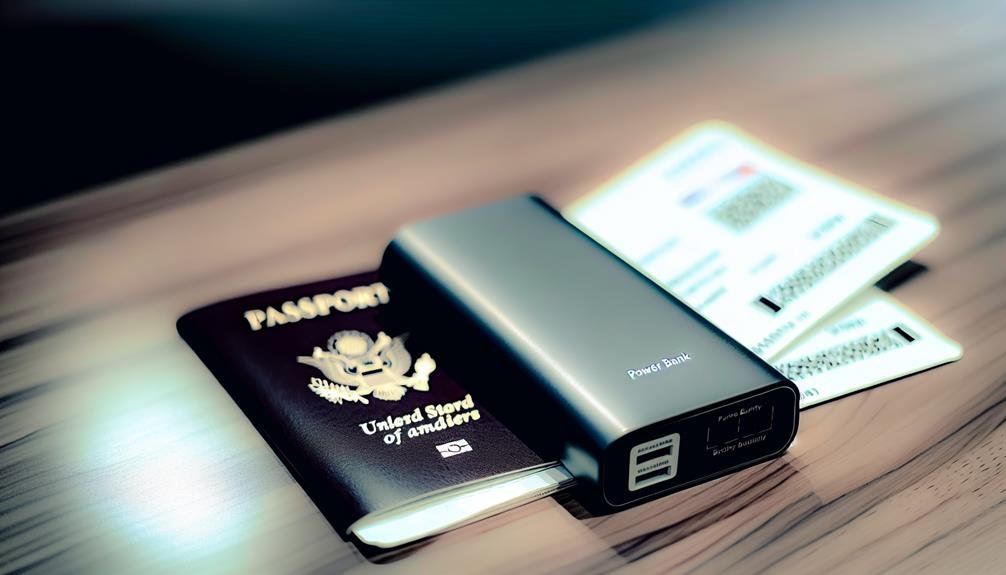
Ensuring the safe transport of power banks on planes requires adherence to specific battery protection guidelines. First, let's talk about charging safety. It's essential to guarantee your power bank has built-in safeguards to prevent overcharging, short-circuiting, and overheating. These features not only protect during charging but also mitigate risks during air travel.
Next, consider battery longevity. Power banks with high-quality lithium-ion or lithium-polymer cells are preferred. They maintain their charge and performance better over time, reducing the likelihood of malfunctions. Make sure your power bank complies with UN 38.3 testing, which covers altitude simulation, thermal tests, and impact tests, ensuring the battery is robust enough for air travel.
Additionally, it's important to store your power bank correctly. Use protective cases to minimize physical damage and avoid exposing them to extreme temperatures. Power banks should be packed in your carry-on luggage rather than checked baggage. This allows for quick access in case of an emergency and adheres to most airline safety regulations.
Ultimately, understanding and following these battery protection guidelines ensures not only your safety but also the safety of fellow passengers. Prioritize power banks with thorough safety features and proper certifications to guarantee a safe journey.
Airline-Specific Rules
When traveling with power banks, it's important to familiarize yourself with airline-specific regulations to avoid any disruptions at security checkpoints. Each airline may have varying rules regarding power bank compatibility, so checking airline policies ahead of your trip is essential for a smooth journey.
Here are three key points to keep in mind:
- Capacity Limits: Most airlines have strict limits on the watt-hour (Wh) rating of power banks. Typically, power banks under 100Wh are allowed in carry-on luggage without prior approval. Devices between 100Wh and 160Wh often require airline permission, while anything above 160Wh is usually prohibited.
- Carry-On Only: Power banks must be carried in your hand luggage. Storing them in checked baggage is generally against airline policies due to the risk of overheating and potential fire hazards, ensuring better battery safety.
- Quantity Restrictions: Some airlines limit the number of power banks you can bring. For example, you may only be allowed to carry up to two power banks with a capacity between 100Wh and 160Wh.
International Guidelines
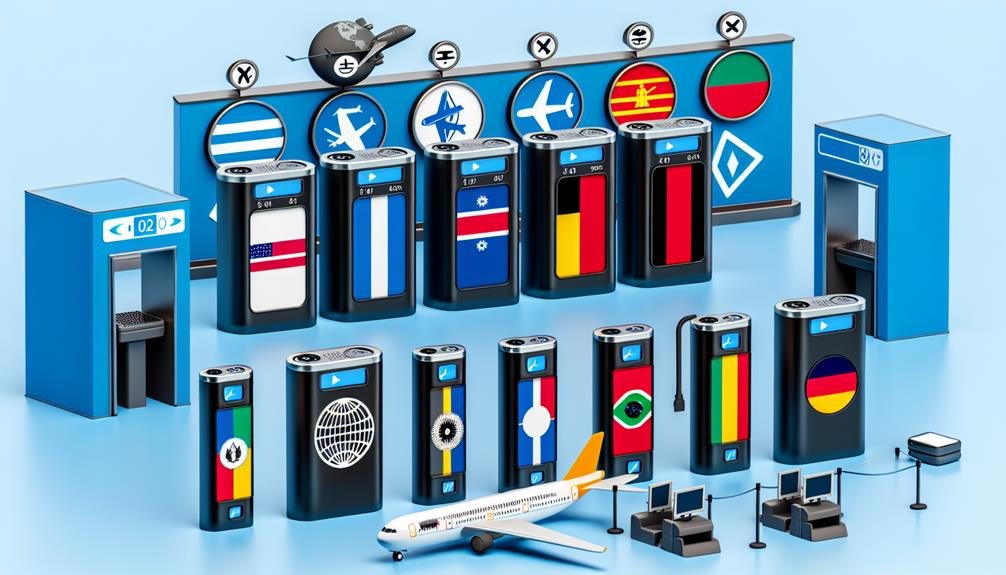
Beyond airline-specific rules, international guidelines also play a significant role in determining how you can travel with power banks across different countries. Adhering to these global standards is important for guaranteeing safety and compliance during your journey.
Primarily, the International Air Transport Association (IATA) sets the benchmark for transporting lithium-ion batteries, including power banks. According to IATA, power banks must be carried in carry-on luggage and are typically restricted to a maximum capacity of 100 watt-hours (Wh). You can bring power banks between 100 Wh and 160 Wh, but you'll need airline approval.
Safety precautions are paramount. Power banks must be protected from short circuits, requiring them to be either in their original packaging or insulated to prevent contact with metal objects. Additionally, each passenger is typically limited to carrying no more than two power banks over 100 Wh.
Travel restrictions can vary slightly by country. For instance, the European Union and the United States follow IATA guidelines closely, but some countries may impose stricter regulations. Always check specific country requirements to make sure your travel essentials comply.
Tips for Travelers
To guarantee smooth travels, always verify your power bank's watt-hour rating and pack it in your carry-on luggage. Confirming compliance with airline regulations not only avoids confiscation but also enhances in-flight safety. Here are some essential tips for travelers:
- Check Voltage Requirements and Watt-Hour Rating: Before flying, validate that your power bank meets the airline's voltage requirements. Most airlines allow power banks with a maximum of 100 watt-hours without prior approval. For those between 100 and 160 watt-hours, you may need airline permission. Always check specific airline guidelines.
- Utilize Safe Charging Options: Opt for power banks with built-in safety measures, such as overcharge protection, short circuit prevention, and temperature control. These features not only keep your devices safe but also secure that the power bank itself doesn't pose a risk.
- Carry Essential Travel Accessories: Include necessary accessories like appropriate charging cables and adapters in your carry-on. This secures that you can charge your devices efficiently during layovers or in-flight. Additionally, having a protective case for your power bank can prevent accidental damage and short circuits.
Frequently Asked Questions
Can I Bring Multiple Power Banks on a Plane?
You can bring multiple power banks on a plane, but each must adhere to power bank capacity limits (usually 100Wh). Power bank charging restrictions apply: they must be in carry-on luggage, not checked baggage, for safety reasons.
Are Power Banks Allowed in Any Luggage Type?
Imagine power banks as little batteries of freedom. You can't place them in checked baggage due to restrictions. However, carry-on luggage is fine if they meet regulations. Always check airline policies to guarantee safety compliance.
Do Power Banks Need to Be Fully Charged to Bring on a Plane?
Power banks don't need to be fully charged to bring on a plane. Charging requirements and safety regulations focus more on capacity limits. Airline policies typically allow power banks up to 100Wh, ensuring compliance with safety standards.
Can I Use My Power Bank During the Flight?
You can use your power bank during the flight, but it's important to follow power bank restrictions. In-flight power bank usage is generally allowed, provided the device complies with airline regulations and isn't over the specified watt-hour limit.
Are There Specific Brands of Power Banks Recommended for Air Travel?
When it comes to the finest brands for air travel, you can't go wrong with Anker or RavPower. They offer high-quality safety features like overcharge protection and temperature control, ensuring your journey remains smooth and safe.

